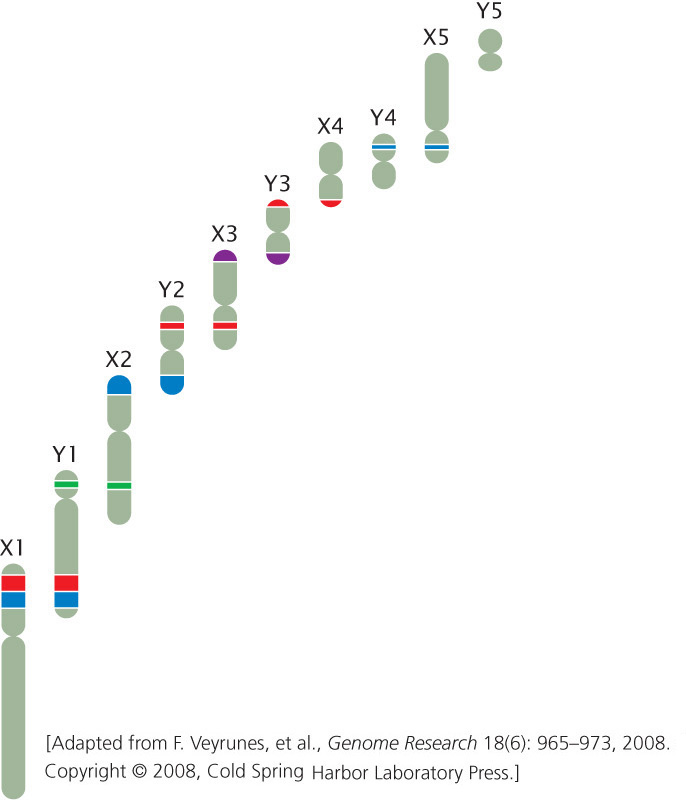The Strange Case of Platypus Sex
77
The platypus, Ornithorhynchus anatinus, is one of life’s strangest animals. It possesses a furry coat and, like a mammal, is warm blooded and produces milk to nourish its young, but it lacks teeth, has a bill, and lays eggs like a bird. It has webbed feet like those of a duck, and females have no nipples (offspring suck milk directly from the abdominal skin); males have spurs on their hind legs that deliver a deadly, snakelike venom. The platypus has such a hodgepodge of mammalian, avian, and reptilian traits that the first scientists to examine a platypus skin specimen thought it might be an elaborate hoax, produced by attaching parts culled from several different organisms. In spite of its strange appearance, the platypus is genetically a monotreme mammal, a side branch that diverged from the rest of mammals some 166 million years ago.

The platypus lives in eastern and southern Australia and on the island of Tasmania. An excellent swimmer, it spends most of its time in small rivers and streams foraging for worms, frogs, insect larvae, shrimp, and crayfish. Among other oddities, it locates its prey by detecting electrical currents they produce (electroreception). The platypus genome was sequenced in 2008, providing a detailed view of the genetic makeup of this strange animal. It has a relatively small genome for a mammal, with 2.3 billion base pairs of DNA and about 18,500 protein-encoding genes. Almost 10% of its genes encode proteins that take part in odor and chemical reception. The platypus genome is a blend of mammalian, reptilian, and unique characteristics.
Platypus sex also is unusual. For most mammals, whether an individual organism is male or female is determined by sex chromosomes. Females possess two X chromosomes, whereas males have a single X chromosome and a smaller sex chromosome called Y. This is the usual type of sex determination in mammals, but how sex is determined in the platypus remained a mystery for many years. The platypus possesses 52 chromosomes, and early geneticists observed a confusing mix of different chromosomes in male and female platypuses, including an unusual chainlike group of chromosomes in meiosis (Figure 4.1).

In 2004, Frank Grutzner and a group of other scientists created fluorescent paints to mark the platypus chromosomes so that they could follow the behavior of individual chromosomes in the course of meiosis. What they discovered was remarkable: platypuses possess ten sex chromosomes: female platypuses have ten X chromosomes, whereas male platypuses have five X chromosomes and five Y chromosomes. In meiosis, these sex chromosomes line up in a precise order, forming a long chain of sex chromosomes. In spite of what at first appears to be mass confusion, the platypus sex chromosomes pair and align with great precision, so that each egg cell gets exactly five Xs; half the sperm get five Xs and the other half get five Ys. The mechanism that brings about this precise separation is not yet known. The complicated set of sex chromosomes in the platypus is just one example of the varied ways in which sex is determined and influences inheritance.
78
In Chapter 3, we studied Mendel’s principles of segregation and independent assortment and saw how these principles explain much about the nature of inheritance. After Mendel’s principles were rediscovered in 1900, biologists began to conduct genetic studies on a wide array of different organisms. As they applied Mendel’s principles more widely, exceptions were observed, and it became necessary to devise extensions of his basic principles of heredity. In this chapter, we will explore one of the major extensions of Mendel’s principles: the inheritance of characteristics encoded by genes located on the sex chromosomes, which often differ in males and females (Figure 4.2). These characteristics and the genes that produce them are referred to as sex linked. To understand the inheritance of sex-linked characteristics, we must first know how sex is determined—why some members of a species are male and others are female. The first part of this chapter focuses on sex determination. The second part examines how characteristics encoded by genes on the sex chromosomes are inherited. In Chapter 5, we will explore some additional ways in which sex and inheritance interact.

As we consider sex determination and sex-linked characteristics, it will be helpful to think about two important principles. First, there are several different mechanisms of sex determination and, ultimately, the mechanism of sex determination controls the inheritance of sex-linked characteristics. Second, like other pairs of chromosomes, the X and Y sex chromosomes pair in the course of meiosis and segregate, but, throughout most of their length, they are not homologous (their gene sequences do not encode the same characteristics): most genes on the X chromosome are different from genes on the Y chromosome. Consequently, males and females do not possess the same number of alleles at sex-linked loci. This difference in the number of sex-linked alleles produces distinct patterns of inheritance in males and females.  TRY PROBLEM 14
TRY PROBLEM 14